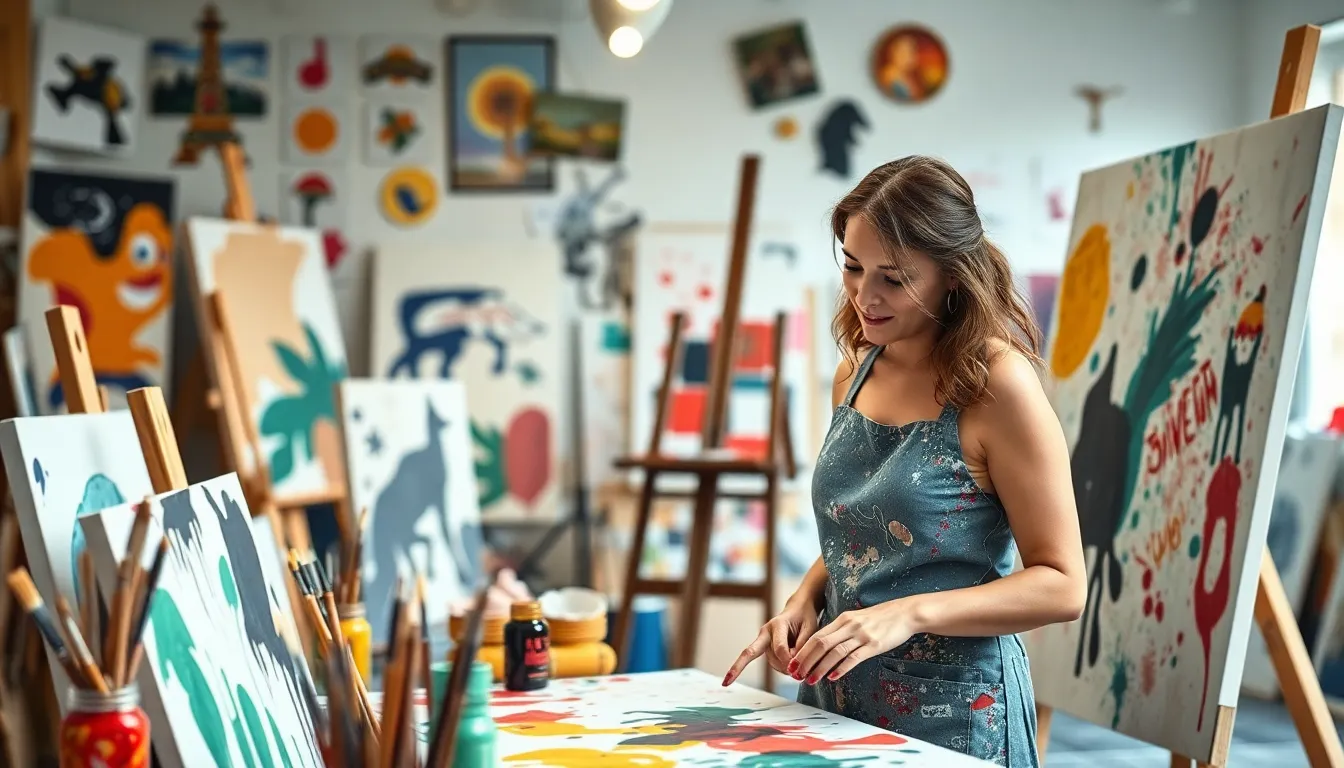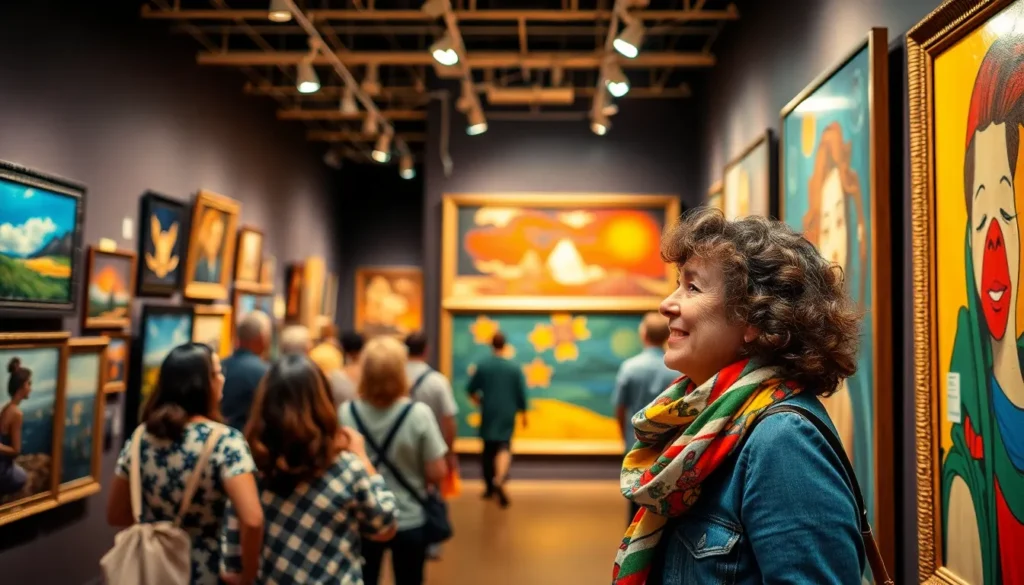Table of Contents
ToggleArt isn’t just a canvas splattered with paint; it’s a universe of emotions, ideas, and a dash of madness. From the flamboyant strokes of Van Gogh to the enigmatic smiles of da Vinci, famous artists have left an indelible mark on the world. Their masterpieces not only ignite conversations but also inspire countless souls to pick up a brush—or at least a crayon.
Imagine walking through a gallery, surrounded by works that have stood the test of time. Each piece tells a story, often more riveting than a soap opera. Whether it’s the drama of Picasso’s cubism or the serene beauty of Monet’s landscapes, these artists have transformed the mundane into the extraordinary. Dive in and explore the lives, quirks, and groundbreaking techniques of these creative geniuses who made the world a more colorful place.
Overview of Famous Artists
Famous artists serve as cultural icons, shaping the landscape of art history. Van Gogh’s unique brushwork and vibrant colors bring emotion to life on canvas. Da Vinci, known for mastery in techniques, created works that explore human anatomy and perspective. Artists like Picasso revolutionized modern art, introducing innovative styles through movements such as Cubism.
Monet’s Impressionist paintings capture the beauty of light and nature, inviting viewers to experience their serene landscapes. Renowned figures, including Frida Kahlo and Georgia O’Keeffe, showcase diverse perspectives and identities through their art. Their storytelling elements resonate with audiences, making personal and universal connections.
Many influential artists emerged from various countries and cultures, enriching global art with unique styles. In the 20th century, artists like Andy Warhol challenged traditional notions of art by blending commercialism with creativity. Sculptors like Michelangelo transformed marble into lifelike figures, displaying incredible skill and artistry.
The works of these artists inspire new generations, encouraging them to express thoughts and feelings through visual mediums. Major art movements, such as Surrealism and Abstract Expressionism, stem from their groundbreaking ideas, reflecting societal changes. Critiques of famous artists’ pieces often lead to discussions about context, technique, and the role of art in society.
Significant exhibitions highlight their contributions and continue to draw art enthusiasts worldwide. Museums and galleries celebrate these artists, with their masterpieces often becoming symbols of cultural identity. By studying their legacies, one gains insights into the world and the transformative power of creativity.
Influential Artists Throughout History

Art reflects societal evolution through various historical movements. Numerous artists have shaped this narrative, leaving lasting impressions on culture and creativity.
The Renaissance Masters
Leonardo da Vinci exemplifies the genius of the Renaissance, blending science and art seamlessly. His iconic works, including the “Mona Lisa,” showcase technical skill and emotional depth. Michelangelo, known for the “David,” pushed the boundaries of sculpture with his remarkable attention to human form. Raphael’s use of perspective and vibrant colors in frescoes demonstrated innovation during this flourishing art period. Collectively, these masters inspired generations of artists and transformed art into a revered discipline.
The Baroque Period
The Baroque period introduced drama and movement into art. Caravaggio utilized stark contrasts of light and dark, creating intense emotional experiences. Rembrandt’s portraits captured human emotion and complexity through masterful use of chiaroscuro. Artists like Peter Paul Rubens produced dynamic compositions, emphasizing energy and grandeur in their works. This era emphasized realism and extravagant expression, influencing artistic narratives for centuries.
Modern Art Innovators
Modern art marked a radical departure from tradition, with artists challenging conventions. Pablo Picasso revolutionized visual expression through Cubism, altering perceptions of form and space. Wassily Kandinsky explored color and abstraction, evoking emotions without representational forms. Jackson Pollock introduced action painting, emphasizing spontaneity and creation processes. These innovators reshaped art’s boundaries, sparking ongoing dialogues about creativity and representation.
Contemporary Famous Artists
Contemporary artists shape the modern art landscape with innovative ideas and diverse perspectives. Their works reflect current themes while pushing artistic boundaries.
Leading Figures in the Art World Today
Damien Hirst stands out as a prominent figure through his explorations of life and death. Yayoi Kusama captivates audiences with her signature polka dots and infinity rooms. Banksy, a street artist, uses provocative imagery to challenge societal norms. Jeff Koons merges high and low art, showcasing his iconic balloon animals. Ai Weiwei advocates for human rights, utilizing art as a means of activism. Each of these artists engages with contemporary issues, influencing both public discourse and artistic expression.
Impactful Art Movements
Street art defines a significant contemporary movement, highlighting urban environments’ vibrancy and social commentary. Digital art emerges as a revolutionary practice, integrating technology and creativity in new ways. Eco-art raises awareness of environmental issues, urging viewers to consider their role in sustainability. Installation art transforms space, inviting audiences to engage interactively with the work. Performance art breaks traditional boundaries, emphasizing the artist’s presence and audience participation. Together, these movements reflect the dynamic nature of today’s art scene, resonating with the global community.
Notable Female Artists
Female artists have significantly shaped the art world, breaking barriers and redefining artistic expression. This section highlights pioneering figures and current trailblazers making waves today.
Pioneers of Feminist Art
Pioneers like Judy Chicago and Miriam Schapiro led the feminist art movement in the 1970s. Their groundbreaking works reclaimed women’s experiences and challenged traditional gender roles. Chicago’s “The Dinner Party” stands as a landmark installation celebrating influential women throughout history. Schapiro’s contribution to collaborative projects emphasized community and dialogue among women artists. Many established a framework for understanding gender in art, inspiring future generations to explore feminist themes.
Current Trailblazers
Contemporary artists like Kerry James Marshall and Tatyana Fazlalizadeh continue evolving the dialogue on identity and representation. Kerry James Marshall’s paintings depict African American experiences, challenging the absence of these narratives in art history. Tatyana Fazlalizadeh uses street art to address issues of race and gender, creating powerful public conversations. Their innovative approaches actively reshape modern art landscapes and engage audiences in critical discussions about diversity and inclusion.
Art continues to serve as a powerful medium for expression and connection. The legacies of famous artists resonate through time, inspiring creativity and dialogue across cultures. Their ability to capture the essence of human experience has shaped not only art history but also societal perspectives.
As contemporary artists push boundaries and explore new themes, they carry forward the rich traditions established by their predecessors. The contributions of diverse voices, especially those of female artists, further enrich this vibrant landscape. Each brushstroke and installation invites viewers to reflect, engage, and appreciate the myriad stories art has to tell.



